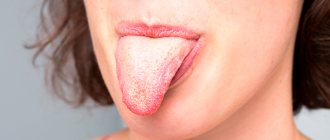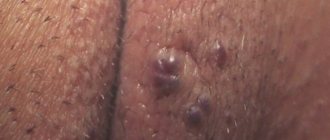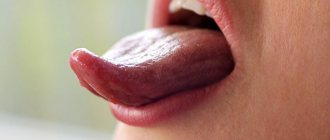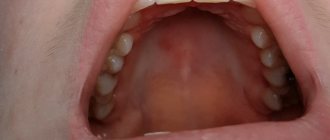Language is a kind of indicator of health status. Some changes in the color, shape, and structure of the taste organ may indicate specific internal pathologies, so you need to pay attention to its appearance.
For example, a raspberry tongue can be a symptom of diseases such as scarlet fever, Kawasaki syndrome, chickenpox, measles . But it can also indicate less obvious pathologies: renal failure, vitamin deficiency. A complete list of diseases that can cause the tongue to turn red, and methods to combat them are listed in the article.
Plaque research
intensity, color and thickness
If the plaque is sticky and difficult to remove from the surface, then there is a reason to take care of examining the patient for gastroenteritis; the presence of a putrid odor promises confirmation of the diagnosis. A thin whitish layer, easily removed, with a metallic taste in the mouth, indicates damage to the stomach and intestines.
A greasy deposit like sludge indicates stagnation of food in the intestines, accumulation of excess mucus, and poor digestion of food. A whitish layer at the base of the tongue indicates enterocolitis, the same at the edges and on the front, not reaching the tip, shows pulmonary problems. If the latter type of deposits turns into a foam-like layer, it means that the patient has chronic bronchitis.
A yellowish coating indicates problems with the gallbladder and ducts, and if it is located in the lower region of the organ, then jaundice begins. If the entire tongue is covered with yellowness, the liver is not working properly, there is excess bile, cholecystitis and problems with the digestive system develop.
The brown color of the layer indicates serious problems with the lungs and stomach; the same sign evenly in the middle part of the tongue, symmetrically with respect to the middle groove, indicates bilateral pneumonia. A black-brown coating, difficult to remove, resembling a chessboard, occurs with pellagra, namely, a deficiency of B vitamins and nicotinic acid. At a late stage of the disease, the organ turns red, and the surface resembles a varnished coating.
Diagnosis of diseases of internal organs by language has been worked out over decades of medical practice. But it is the doctor, seeing the first signs of the disease, who will prescribe an examination and determine the true cause of the appearance of changes on the surface of the tongue. The patient can only raise the alarm on his own; all other actions remain the prerogative of the specialist.
Tongue diseases
A lacquered tongue is observed when
Changes in the condition of the mucous membrane of the tongue are an indicator of pathogenic processes in the body
A special symptom of the mucous membrane of the tongue is the so-called “lacquered tongue”. It occurs when the taste buds atrophy.
The tongue becomes smooth, which causes the shine characteristic of other mucous surfaces of the mouth to appear. A lacquered tongue occurs with loss of the ability to absorb vitamin B2, chronic colitis and stomach cancer.
Due to the first reason, there is a deficiency of vitamins PP and B2 - pellagra, the second symptom of which is a brown, hard-to-remove plaque covered with cracks in a checkerboard pattern. Advanced pellagra causes the return of the symptom of a varnished tongue and its severe redness. The bright red lacquered tongue is called "cardinal tongue".
A varnished tongue is a sign of anemia
Another cause of a lacquered tongue is anemia. This disease in most cases occurs due to a lack of vitamins B9 and B12, as well as iron, in the body. With anemia, the tongue, in addition to redness, acquires a glossy shine. The appearance of shine is explained by the fact that during anemia the papillae of the tongue atrophy and their smoothing is observed.
The main symptoms of anemia are:
- drying and peeling of the skin;
- deterioration of hair and nails;
- redness of the tongue;
- in severe cases of the disease, cracks may appear on the palms and soles;
- weakened immunity, which can, in parallel with anemia, lead to colds, flu, bronchitis and other similar ailments;
- lethargy; mood swings;
- dizziness, sometimes even fainting;
- vomit; constipation or diarrhea.
Anemia
Anemia, also called anemia, is characterized by a low concentration of hemoglobin in the blood, and its different types differ in color, severity and other characteristics. One of the varieties is B12 deficiency anemia, also called Addison-Birmer disease, a feature of which is a lack of vitamin B12 in the body, which is necessary for the normal functioning of the bone marrow and central nervous system.
A red tongue is one of the symptoms of anemia.
Frequent accompaniments of this disease are neurological disorders: numbness of the limbs and ataxia due to the death of nerve cells. A red tongue is also one of the symptoms of this type of anemia, and as the disease progresses, it takes on a “varnished” appearance caused by damage to its surface.
Additional Information . In addition to the obvious cause of the disease in the form of a lack of vitamin B12 in the diet, the development of this anemia is influenced by some disorders and diseases of the gastrointestinal tract (including helminths and cancer), as well as heredity.
Inflammation
The most common reason leading to a change in the color of the mucous surface of the tongue is its inflammation. The etiology of the process includes a complex of probable factors, so all types of inflammation of the tongue were combined into a common group of diseases called glossitis. All types of glossitis cause the tongue to become discolored, but not all cases are red.
In addition, hyperemia is not the only symptom of inflammation, although a red tongue may indicate the onset of the disease. Types of glossitis that can lead to redness of the mucous membrane of the tongue are as follows:
- desquamative;
- Gunter's;
- diamond-shaped;
- catarrhal;
- atrophic;
- allergic.
All types of glossitis cause the tongue to become discolored, but not all cases are red.
Depending on the type of glossitis, the features of redness of the tongue (partial or complete) and the shade of red may vary. To make a preliminary diagnosis, it will be necessary to analyze the remaining symptoms, some of which are characteristic only of one type of disease, and the other part relates to the general clinical picture.
One of the most common signs is swelling of the tongue, as well as plaque on its surface and impaired salivation. In addition, small ulcers or erosions may appear in the mouth and tongue, causing an unpleasant odor, and the patient may experience a slight increase in temperature.
Important! Treatment of glossitis is primarily symptomatic and is based on the use of antiseptics, anti-inflammatory and anesthetic agents. If the inflammation is the result of some internal disease, then this cause will need to be eliminated, otherwise glossitis will recur
Scarlet fever
Tongue with scarlet fever.
Another probable cause that can provoke redness of the mucous membrane of the tongue is scarlet fever, an infectious disease caused by streptococcus. The disease is contagious and is transmitted both from a sick person to a healthy person, as well as from a recently ill person or simply a carrier.
Scarlet fever is accompanied by a whole range of symptoms, one of which is the so-called crimson tongue: a few days after the onset of the disease, the mucous membrane of the tongue becomes bright red and granular in appearance. Other signs of the disease look like this:
- fever;
- headache;
- malaise;
- small rash;
- angina;
- exfoliation of the skin in the final phase.
Treatment of scarlet fever most often takes place at home, while the patient is prescribed to remain in bed, drink plenty of warm liquids, and follow a gentle diet. Drug therapy includes, first of all, the use of penicillin-based antibiotics (Phenoxymethylpenicillin, Amoxicillin, Ampicillin and others). It is equally important to support the patient’s immunity through the use of vitamins C and B.
Note! In severe cases, if the patient requires hospitalization, intravenous administration of a glucose solution may be necessary to relieve symptoms of intoxication.
Lacquered tongue
When examining the tongue, the doctor determines its color, shape, swelling, thickness, moisture, teeth marks, the severity of the vessels under the tongue, the color and nature of plaque. A healthy person's tongue is pink, clean and shiny; plaque indicates the presence of some disease. An equally important indicator is the violation of the relief of the tongue, the appearance of various grooves. This often indicates a violation of vitamin metabolism.
The organ appears varnished as a result of atrophy of its papillae. With some pathologies, the number of papillae decreases, sometimes they disappear altogether. As a result, it looks smooth, shiny, as if varnished. This condition is typical for malignant tumors of the stomach, vitamin B12 deficiency, and chronic colitis.
The smooth surface of the tongue, the so-called varnished tongue, often appears with iron deficiency and B12 deficiency anemia
A type of “varnished” tongue includes the so-called “chessboard” tongue, which is covered with a difficult-to-remove coating of black-brown color, with cracks resembling a chessboard.
This happens with pellagra (deficiency of nicotinic acid and vitamin B). In the late stage of pellagra, the tongue acquires a red tint with a varnished surface - “cardinal tongue”.
A disease that causes a varnished tongue
A smooth surface of the tongue, the so-called “polished” or “varnished” tongue, often appears with iron deficiency and B12 deficiency (pernicious) anemia, as well as with a deficiency of vitamins B2 and PP. The factors that lead to such changes in the mucous membrane of the tongue also affect the mucous membrane of the stomach and intestines: the same changes occur there - atrophy of the gastric mucosa.
Vitamin B12 is necessary for normal hematopoiesis, the formation of epithelial cells, the functioning of the nervous system (participates in the formation of myelin), growth and regeneration processes.
The lacquered tongue is observed:
- megaloblastic anemia (pernicious anemia, pernicious anemia, Addison-Biermer anemia);
- lesions of the digestive tract (the tongue becomes bright red, smooth, highly sensitive to chemical irritants, atrophy of the gastric mucosa and achylia are noted);
- disorders of the nervous system (paresthesia, pain, gait disturbances).
The crimson lacquered tongue is characteristic
The reasons for changes in the color and tongue to raspberry color in adults may be gastritis, pneumonia, poisoning, lack of vitamin B12
The reasons for the change in the color of the tongue to crimson in adults may be gastritis; pneumonia; poisoning; lack of vitamin B12. A raspberry tongue may be associated with chronic liver disease.
Problems with the gastrointestinal tract, in particular gastritis, will be indicated by a bright crimson tongue coated. At the same time, the intensity of plaque accumulation will be uneven: there will be less of it along the edges and at the tip, and more in the center. At the same time, the appearance of a burning sensation on the tongue indicates a decrease in stomach acidity.
With a lack of vitamin B12, a severe form of anemia may occur. It develops against the background of poor absorption of vitamin B12 in the body or its insufficient intake from food. Nerve cells and bone marrow especially suffer from vitamin B12 deficiency. One of the signs of anemia is a raspberry lacquered tongue.
Red lacquered tongue
“Red lacquered” tongue, or atrophic glossitis (the surface of the tongue is bright red, shiny, smooth due to atrophy (death) of the taste buds) - stomach cancer (a malignant tumor arising from the epithelium (surface cells of the stomach)), chronic colitis (inflammation colon), malabsorption of nutrients in the intestine, vitamin B12 deficiency, xerostomia (dry mouth), candidiasis.
- https://si-yanie.com/smartblog/308_diagnostika-po-yazyku.html
- https://www.remedium.ru/doctor/detail.php?ID=2993
- https://buzovanovosti.ru/aksessuary/raspberry-tongue-in-adult-causes-diagnosis-of-diseases-by-language.html
Post Views: 448
Diet
With any changes in the language, it is first necessary to normalize the diet. Excluded from the menu:
- Fast food;
- Fatty meat (pork, lamb, duck);
- Salty and spicy foods;
- Smoked meats and marinades;
- Carbonated drinks;
- Alcohol;
- Bakery and sweets;
- Mushrooms.
Pathological diseases of the oral cavity are very diverse and do not always have characteristic symptoms.
Some diseases develop gradually, unnoticed by the patient, and only a doctor can detect them during the next examination.
This happens with, or more precisely, its variety - Gunter's glossitis.
Glossitis is an inflammatory disease that develops on the mucous membrane of the tongue.
In this case, pathological changes in the mucous membrane occur, it takes on an unusual appearance, and sometimes this process is accompanied by unpleasant sensations.
Discomfort in the oral cavity is the first sign of the development of glossitis
As a rule, glossitis is not an independent disease, but one of the signs of serious disorders in the body. If we talk about Gunter's glossitis, it is one of the symptoms of anemia that occurs due to a lack of vitamin B12 and folic acid in the patient's body.
Changes in the mucous membrane of the tongue during the development of Gunter's glossitis acquire the following features:
- the surface of the tongue becomes very smooth, as if polished;
- the color of the mucous membrane becomes very bright, crimson;
- There may be a slight burning sensation in the mouth.
The papillae of the tongue, mainly in the root zone, become atrophic and smoothed. The mucous membrane of the tongue becomes covered with reddish areas of inflammation, located mainly along the edges and at the tip; aphthous rashes and cracks may appear. Similar changes can occur in the mucous membrane of the gums, cheeks, pharynx, soft palate, and even the esophagus.
In parallel, atrophy of the gastric mucosa is observed, which is most pronounced in the fundus area; the folds of this mucosa become smooth or not defined at all, the walls of the stomach become thinner, and polypous growths may appear on them.
Development occurs gradually; first, symptoms similar to the inflammatory process appear, the tongue becomes scalded or inflamed. Then atrophic processes occur on it, leading to changes in the mucosa, which can subsequently “spread” to the gums, cheeks and other mucous membranes of the mouth and esophagus.
Features of treatment
Raspberry tongue is most often not a disease, but a symptom, so the cause of the disease must be treated. In such situations, comprehensive treatment is prescribed, which includes the elimination of drugs that can cause allergic reactions, a balanced diet, rinsing the mouth with an antiseptic, for example, Furacilin or Chlorhexidine, and rinsing with a herbal decoction.
If the patient has pain or discomfort, rinsing the mouth with an anesthetic is also prescribed.
In complex and advanced cases, even surgery may be required to remove damaged tissue. Antibiotics are used to restore the body.
Diagnosis of diseases by language
Most people wonder how to determine a disease by the tongue, because its changes in color and “texture” indicate not only the condition of the oral cavity, but also malfunctions in the body; it can effectively tell which doctor to contact in case of a tongue disease.
First of all, you need to create a correspondence diagram:
- part of the tip carries information about the condition of the heart and lungs;
- the middle “monitors” the pancreas, liver and spleen;
- the root is responsible for the digestive organ;
- lateral zones (closer to the root) - buds.
The placement of the sections schematically follows the arrangement of organs in the human body.
Self-diagnosis can be carried out
To do this, you need to examine the oral cavity in daylight in the morning, on an empty stomach, and pay attention to:
- an unpleasant companion to some ailments is a characteristic bad breath;
- shade and appearance of the tongue;
- presence of plaque, its features;
- structural changes in the surface (ulcers, cracks).
Why is my tongue red and stinging?
The causes of these unpleasant symptoms can be both external factors and various diseases of the oral cavity. In each specific case, it is necessary to identify the exact cause of the burning sensation and select the appropriate treatment if necessary.
External provoking factors
Specific food
A common non-dental cause of tongue tingling is eating pineapple. This fruit, if not ripe enough, contains more acids that corrode the sensitive oral mucosa.
Bromelain is one of the causes of burning and redness of the tongue and palate. There is especially a lot of it in unripe pineapple. This is an enzyme capable of breaking down protein. If we take into account that a person consists of protein, then the pineapple “eats” us while we eat it.
Also, any other overly salty, spicy or sour food can cause discomfort in the oral cavity. Especially if your food contains a lot of pepper. This occurs due to severe irritation of the sensitive receptors of the tongue.
Cigarettes
Another burning sensation is smoking. The reason lies in the burn of the mucous membrane. Hot tobacco smoke can be very harmful, and if you add to all this the influence of nicotine, tar and other dubious substances released when smoking, then a burning tongue is the least unpleasant thing you can get.
Tongue tip injuries
Various mechanical impacts can easily cause injury to the tongue. The cause may be an incorrect bite, haste while eating and talking. An incorrectly installed prosthesis or if it is not the right size increases the likelihood of biting your tongue when closing your jaw.
Trying to chew nuts with your teeth doesn't do any good either. In addition to breaking teeth, the sharp edges of the shell severely injure the mucous membrane.
Taking a certain group of drugs
Medicines containing chemical and some herbal components, when taken orally, can irritate the mucous membranes, cause inflammation and affect the surface of the tongue. The first reaction becomes noticeable at its tip - itching, tingling and redness occur.
Allergic reactions
If the body is hypersensitive to certain substances from the outside, not only the skin, but also the tongue can react. Tongue tingling may occur if you are intolerant to any component of the toothpaste, mouthwash, or have a reaction to food.
Oral diseases as a cause of discomfort
Tartar
His education is related to dental disorders.
Tartar consists of a large number of pathogenic microorganisms that produce toxins.
Frequent contact of the tongue with the affected surface can lead to almost imperceptible inflammation of the mucous membrane.
This causes symptoms such as: the tongue stings and the tip turns red.
Stomatitis and herpes
These are two completely different diseases in origin, but they have similar symptoms. During exacerbation, redness and tingling of the tongue are observed.
Candidiasis
The fungus affects the entire mucous membrane of the oral cavity, but it is the tongue that suffers the most. A white coating forms on it and it swells slightly. Its walls may become thinner, which will cause an increased reaction in the form of a burning sensation.
Dry mouth
A common disease that involves the tongue itself, and especially its edges. It reacts sharply to lack of moisture. Due to the occurrence of many small cracks, sensations appear in the form of burning and redness.
Bruxism
Possible cause of tongue pain. Uncontrolled clenching of the jaw and grinding of teeth can easily lead to accidental injury to a muscular organ.
Glossitis
Infectious disease. A characteristic symptom is redness and swelling of the tongue. In the future, the discomfort only intensifies and can lead to difficulty speaking.
Also, a burning sensation and redness of the tongue can be caused by a number of diseases of internal organs and systems.
Among them, the most notable are:
- Gastritis. With increased acidity, due to the high concentration of gastric juice, a malfunction of the stomach occurs. As a result of reflux, contents from the stomach are thrown back into the esophagus and throat. When it enters the oral cavity, hydrochloric acid irritates the mucous membranes, including the tongue. This is where the tingling begins.
- Anemia. With a deficiency of iron and folic acid, a burning sensation of the tongue and the entire oral cavity often develops.
Also, this symptomatology is characteristic of liver disease, kidney failure, diabetes, pinched occipital nerve, menopause, certain heart diseases and lichen planus.
Causes of the red surface of the tongue and the appearance of plaque
Here we will look at the reasons why a person’s red tongue is covered with a characteristic overlay.
- You must have noticed that with a sharp increase in temperature, heat and fever, the entire face and skin may become red and swollen. The same applies to the oral cavity.
- Dry scarlet deposits are caused by inflammation of the gray matter of the brain, as well as its outer layers. The same symptoms are caused by inflammation of the gastrointestinal tract, intestinal mucosa and even lungs.
- The cause of the shiny, glossy sediment is a critical level of body temperature and multiple burns to the body.
Scarlet fever
- A change in color to a red-crimson hue can indicate severe systemic diseases of a viral or infectious nature. As a rule, the therapist diagnoses a sore throat, pneumonia or scarlet fever based on this color of the tongue. If we are talking about the latter, then another symptom for diagnosis can be considered inflammation of the papillae on the tip and back of the tongue. If the red color of the muscle darkens, then you should look for kidney diseases and infections, or suspect intoxication of the body. The cherry hue also speaks of infectious and viral diseases such as measles and influenza.
- Allergies to cosmetics and food elements manifest themselves in the form of uneven scarlet spots appearing on the mucous membrane.
- Burns and injuries to the organ also lead to swelling and redness of its surface.
- The specific disease Kaposi's sarcoma manifests itself in the form of characteristic spots on the muscle with a dense blue coating on them.
- Anemia (anemia) leads to a painful and pale color of the oral cavity, while the muscle remains unnaturally red.
- Red and slightly brownish sediment on the surface is left by bad habits, such as drinking wine, overusing coffee and tea products, and smoking.
- Also, characteristic overlays are caused by parasites in the body.
- Let’s not forget about the tongue disease glossitis, which is always accompanied by redness.
- Surprisingly, even an ordinary dark stone, as well as advanced caries, can contribute to unnatural deposits on the mucous membrane.
- Patients often notice a red tongue after taking courses of antibiotics.
Associated symptoms
Many pathologies, in addition to burning and redness of the tip of the tongue, are accompanied by numbness and swelling. In some cases, cracks appear on the surface of the mucosa, which can subsequently bleed. Scarlet spots due to candidiasis are hidden by a cheesy coating. Sometimes tingling of the organ is accompanied by the appearance of white bubbles throughout the oral cavity.
Causes of pimples on the tongue
The main causes of rashes:
- Traumatic injuries, burns. It is not uncommon for the tip or side surface of the tongue to be damaged by cutlery, excessively hot food, or one’s own teeth.
- Weakened immunity. When pimples appear on the tongue closer to the throat, at its base or near the frenulum, this may indicate reduced immunity. A variety of pimples and bumps are localized here: condylomas and warts, candidal bumps.
- Development of benign and malignant tumors.
- Poor nutrition, bad habits. If you violate the rules of nutrition, excessive consumption of spicy, hot, rough foods, an irritating and traumatic effect on the mucous membrane occurs, which provokes the appearance of pimples. Excessive smoking and alcoholic libations also cause diseases of the mucous membranes in adults.
- The causes of lumps at the end and root of the tongue may be allergic. Allergic disease manifests itself not only on the skin, but also on mucous membranes.
Large bumps located close to the pharynx make it difficult to swallow food and can lead to breathing blockage.
- If pimples appear on the tongue closer to the larynx, they could be caused by various diseases of a chronic, viral and infectious nature.
- Neglect of hygiene rules. Eating unwashed foods and irregular oral hygiene not only in children, but also in adults, causes irritation of the mucous membrane and, as a result, the appearance of inflamed pimples.
In most cases, bumps at the base of the tongue, pimples on the side, growths on the tip of the tongue are manifestations of the following diseases:
Diseases of the mucous membrane of an inflammatory nature (glossitis) are accompanied by the formation of painful red rashes on the mucous membrane, in severe form - abscesses, phlegmons.
- Metabolic disorders, vitamin deficiency. Such conditions are characterized by redness and enlargement of the taste buds, which often become inflamed and acquire a red-white color.
- Herpes, characterized by the appearance of painful red pimples and blisters.
If red bumps or nodules appear on the base of the tongue, this may be a symptom of pyogenic granuloma. The formations consist of blood vessels and are localized in the wounded area. Pathology occurs due to injuries and damage to the mucous membrane. When touching the formations, a person feels a sharp pain.
- Digestive disorders (malabsorption). Pimples on the root, all over the surface of the tongue, are one of the symptoms of this pathology.
- Candidiasis (thrush). A disease that often affects newborns. The child's tongue becomes covered with red bumps and a cheesy coating forms. The baby behaves restlessly, cries, and has difficulty swallowing; these symptoms are caused by itchy red-white pimples and dry mouth.
- HPV – human papillomavirus. Formations are localized in any area of the tongue: at the tip, root, side. The bumps on the tongue closer to the larynx cause particular discomfort, as they interfere with swallowing and create the sensation of a foreign object in the mouth.
- Allergic diseases. The rashes do not hurt, but they interfere with swallowing and speaking.
- Diseases common to children: chickenpox, measles.
Kawasaki syndrome
The disease is complicated by the increased likelihood of damage to important blood vessels.
A serious disease unique to childhood is Kawasaki syndrome, which is an acute fever. The disease is complicated by an increased likelihood of damage to important blood vessels with subsequent thrombosis and rupture of the walls, which makes it deadly.
The cause of the syndrome has not yet been precisely studied, but the main hypothesis suggests a connection between the body’s immune response to an increase in the number of T-lymphocytes and the presence of antigens to staphylococci and streptococci.
The assumption that a child has this disease is based on prolonged (at least five days) fever, accompanied by any four symptoms from the following list:
- the tongue is red due to infection of the entire mucous membrane of the mouth and throat;
- redness of the eye sclera;
- erythema, peeling or swelling of the hands and feet;
- a rash on the body similar to measles, but without blisters;
- pronounced enlargement of the cervical lymph nodes.
It is impossible to completely cure a child of Kawasaki syndrome, so treatment is symptomatic and includes intravenous administration of immunoglobulins, the use of non-steroidal anti-inflammatory drugs and corticosteroids.
Diseases that our tongue can tell about.
The appearance of plaque on the tongue may indicate various diseases, but sometimes it is observed in a minor form in a healthy person. In particular, in adolescents during puberty, plaque may form due to a hormonal surge. A light, white and odorless coating through which the pink color of the tongue can be seen is considered acceptable.
By the way, in summer the plaque is more pronounced, but the papillae of the mucous membrane are clearly visible, in the fall the plaque is drier and lighter, and in winter it has a yellowish tint
It is also important to maintain oral hygiene: use special toothbrushes with a ribbed back surface for the tongue
WHAT TO DO WHEN A CHILD HAS A CARRIBON TONGUE?
A crimson tongue can be a symptom of a disease, but the procedure largely depends on its cause. If you have alarming symptoms, you should consult a doctor.
Treatment of scarlet fever will be based on the use of an appropriate antibiotic
For Kawasaki disease, it is important to start treatment as early as possible. It involves the use of infusions of immunoglobulins, acetylsalicylic acid, and sometimes steroids
Vitamin deficiencies may require their use, changes in diet or treatment of diseases that result (for example, nonspecific intestinal inflammation). Large amounts of vitamin B12 are found in animal products such as meat, milk, fish, and eggs. Vegetables and fruits rich in folic acid include spinach, broccoli, legumes, kiwi, and oranges. The source of iron for the body can be, for example, liver, red meat, legumes, nuts, cocoa. If the cause of glossitis is a fungal infection, it requires treatment with appropriate antifungal drugs.
Cirrhosis of the liver
A red “varnished” tongue is often found in patients with cirrhosis of the liver.
A red “lacquered” tongue is often found in patients with cirrhosis of the liver, a chronic disease characterized by the formation of fibrous tissue in this organ. This is a deadly disease, from which it is almost impossible to completely recover if it is fully formed - the only reliable option is a liver transplant.
Otherwise, patients begin to complain of weakness, dyspepsia, fever and joint pain. Next, asthenia occurs and weight loss develops, and the liver itself increases in size and becomes deformed. At this stage, the patient is prescribed a strict diet, especially since he begins to suffer from a constant feeling of nausea and vomiting. In the terminal stage of cirrhosis, jaundice develops, swelling of the legs and varicose veins of the gastrointestinal tract occur, followed by bleeding - often fatal.
To prevent the occurrence of cirrhosis, doctors recommend following a proper diet and avoiding alcohol consumption.
Secondary medical education
- General midwife
- Dental assistant
- Dentist
- Dentist
- Dental Technician
- General expert research laboratory assistant
- Blood service laboratory technician
- AIDS service laboratory technician
- Laboratory assistant of forensic biological departments
- Laboratory assistant of forensic histology departments
- Laboratory assistant of physical and technical departments
- Laboratory assistant at chemical and toxicological departments
- Gynecological nurse
- Neonatology nurse
- General practice nurse
- Nurse of the intensive care and anesthesiology departments
- Ophthalmic nurse
- Pediatric nurse
- Physical therapy nurse
- Nutritional Nurse
- Massage nurse
- Care nurse
- Healthy lifestyle nurse
- Tuberculosis service nurse
- Psychoneurological nurse
- Blood service nurse
- AIDS service nurse
- Dental nurse
- Therapeutic nurse
- Physiotherapeutic nurse
- Surgical nurse
- Medical statistician
- Laboratory assistant doctor
- Nurse's assistant
- X-ray technician
- Paramedic laboratory assistant
- Narcology paramedic
- General practitioner
- Paramedic of the public education system
Category: Medicine / FindHow.org
Information on the topic
- Online testing for certification of medical specialists
- Free treatment according to the guaranteed volume of medical care in Kazakhstan
- List of clinical stations for medical category
- How are healthcare professionals certified?
- How to attach to a clinic in Kazakhstan
- Online testing of energy specialists
- Register of medical organizations
- Trial online testing UNT
- Trial online testing for the civil service of the Republic of Kazakhstan
- How to find a job without experience in Kazakhstan
- Laws for civil service tests in Kazakhstan
- Frequently asked questions about online testing (law enforcement)
- Rules for admission to universities in Kazakhstan
- How to enter the Ministry of Internal Affairs of the Republic of Kazakhstan
- Compulsory social health insurance (OSHI) in Kazakhstan
- Online testing of engineers in the field of construction and architecture











